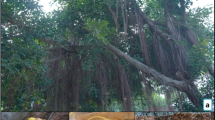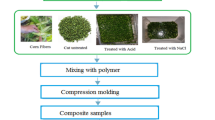Abstract
Lignocellulosic fibers extracted from the curaua plant are among the strongest natural fibers used as polymer composite reinforcements for engineering applications. However, to date, such composites have been limited in terms of their mechanical strength and impact energy. The objective of the present work is to investigate the possibility of improving the tensile strength as well as impact energy of curaua fiber-reinforced polyester composites by varying the process parameters, i.e., the amount of fibers with thinner diameter and the pressure applied during composite preparation. Using 60 vol.% of thinner, continuous, and aligned curaua fibers, it was possible to obtain tensile strength above 200 MPa. Moreover, by applying pressure of 30 MPa during curing, composites with tensile strength above 270 MPa were obtained. Regarding the Izod impact resistance, toughness of over 340 J/m was obtained for notched specimens machined perpendicular to the fiber alignment direction.








Similar content being viewed by others
References
S.N. Monteiro, F.P.D. Lopes, A.P. Barbosa, A.B. Bevitori, I.L.A. da Silva, and L.L. da Costa, Metall. Mater. Trans. A 42, 2963 (2011).
A.K. Mohanty, M. Misra, and G. Hinrichsen, Macromol. Mater. Eng. 276, 1 (2000).
S.J. Eichhorn, C.A. Baillie, N. Zafeiropoulos, L.Y. Mwaikambo, M.P. Ansell, A. Dufresne, K.M. Entwistle, P.J. Herrera-Franco, G.C. Escamilla, L. Groom, M. Hughes, C. Hill, T.G. Rials, and P.M. Wild, J. Mater. Sci. 36, 2107 (2001).
A.K. Mohanty, M. Misra, and L.T. Drzal, J. Polym. Environ. 10, 19 (2002).
A.N. Netravali and S. Chabba, Mater. Today 6, 22 (2003).
J. Crocker, Mater. Technol. 2–3, 174 (2008).
S.N. Monteiro, F.P.D. Lopes, A.S. Ferreira, and D.C.O. Nascimento, JOM 61, 17 (2009).
M.J. John and S. Thomas, Carbohydr. Polym. 71, 343 (2008).
V.K. Thakur, A.S. Singha, and M.K. Thakur, J. Polym. Environ. 20, 412–421 (2012).
O. Faruk, A.K. Bledzki, H.P. Fink, and M. Sain, Prog. Polym. Sci. 37, 1555 (2012).
V.K. Thakur, A.S. Singha, and M.K. Thakur, Int. J. Polym. Mater. 62, 226–230 (2013).
V.K. Thakur, M.K. Thakur, and R.K. Gupta, Intl. J. Polym. Anal. Charact. 19, 256 (2014).
O. Güven, S.N. Monteiro, E.A.B. Moura, and J.W. Drelich, Polym. Rev. 56, 702 (2016).
K.L. Pickering, M.G.A. Efendy, and T.M. Le, Compos. Part A 83, 98 (2016).
J. Wróblewska-Krepsztul, T. Rydzkowski, G. Borowski, M. Szczypiński, T. Klepka, and V.K. Thakur, Int. J. Polym. Anal. Charact. 23, 383–395 (2018).
S.P. Dubey, V.K. Thakur, S. Krishnaswamy, H.A. Abhyankar, V. Marchante, and J.L. Brighton, Vacuum 146, 655–663 (2017).
J. Holbery and D. Houston, JOM 58, 80 (2006).
R. Zah, R. Hischier, A.L. Leão, and I. Braun, J. Clean. Prod. 15, 1032 (2007).
N. Thomas, S.A. Paul, L.A. Pothan, and B. Deepa, Natural fibers: structure, properties and application.Cellulose Fibers: Bio- and Nano-polymer Composites, ed. S. Kalia, B.S. Kaith, and I. Kaur (Berlin-Heidelberg: Springer, 2011), p. 3.
Z. Benzait and L. Trabzon, J. Compos. Mater. (2018). https://doi.org/10.1177/0021998318764002.
P. Wambua, J. Ivens, and I. Verpoest, Compos. Sci. Technol. 63, 1259 (2003).
S.V. Joshi, L.T. Drzal, A.K. Mohanty, and S. Arora, Compos. Part A 35, 371 (2004).
F. Tomczak, K.G. Satyanarayana, and T.H.D. Sydenstricker, Compos. Part A 38, 2227 (2007).
M.A.S. Spinacé, C.S. Lambert, K.K.G. Fermoselli, and M. De Paoli, Carbohydr. Polym. 77, 47 (2009).
K.G. Satyanarayana, J.L. Guimarães, and F. Wypych, Compos. Part A 38, 1694 (2007).
F.H. Oliveira, A.L. Helfer, and S.C. Amico, Macromol. Symp. 319, 83 (2012).
J.H. Almeida Jr, H.L. Ornaghi Jr, S.C. Amico, and F.D.R. Amado, Mater. Des. 42, 111 (2012).
D.O. Castro, A. Ruvolo Filho, and E. Frollini, Polym. Test. 31, 880 (2012).
C.C. Angrizani, M.O.H. Cioffi, A.J. Zatteri, and S.C. Amico, J. Reinf. Plast. Compos. 33, 472 (2014).
S.N. Monteiro, F.O. Braga, E.P. Lima Jr, L.H.L. Louro, and J.W. Drelich, Polym. Eng. Sci. 57, 947 (2017).
M.Z. Rong, M.Q. Zhang, Y. Liu, G.C. Yang, and H.M. Zeng, Compos. Sci. Technol. 61, 1437 (2001).
S.N. Monteiro, K.G. Satyanarayana, A.S. Ferreira, D.C.O. Nascimento, F.P.D. Lopes, and I.L.A. Silva, Materia 15, 488 (2010).
ASTM Designation D638, Standard Method for Tensile Properties of Plastics, West Conshohocken (2015).
ASTM Designation D256, Standard Test Methods for Determining the Izod Pendulum Impact Resistance of Plastics. West Conshohocken (2015).
F.O. Braga, N.T. Simonassi, A.C. Cabral, S.N. Monteiro, and F.S. Assis, Tensile and impact properties of two fiber configurations for curaua reinforced composites. Proceedings of the 3rd Panamerican Materials Congress, ed. M.A. Meyers, et al. (San Diego: The Minerals, Metals and Materials Society, 2017), p. 429.
A.L. Leão, I.H. Tan, and J.C. Caraschi, Curaua fiber—a tropical natural fiber from Amazon—potential and applications in composites, in Proceedings of the International Conference on Advanced Composites (Hurghada, Egypt: Yasser G. & Faissal, 1998), p. 557.
S.N. Monteiro, L.L. Da Costa, F.P.D. Lopes, and L.A.H. Terrones, Characterization of the impact resistance of coir fiber reinforced polyester composites, in TMS 2008 Annual Meeting Supplemental: Materials Processing and Properties (New Orleans, USA, 2008), vol. 2, p. 131.
K.K. Chawla, Composite Materials Science and Engineering, 3rd ed. (New York: Springer, 2012).
Acknowledgements
The authors acknowledge support of this investigation by the Brazilian agencies CNPq, CAPES, and FAPERJ, and LNDC/UFRJ for performing the tensile tests.
Author information
Authors and Affiliations
Corresponding author
Rights and permissions
About this article
Cite this article
Simonassi, N.T., Braga, F.O. & Monteiro, S.N. Processing of a Green Fiber-Reinforced Composite of High-Performance Curaua Fiber in Polyester. JOM 70, 1958–1964 (2018). https://doi.org/10.1007/s11837-018-3074-y
Received:
Accepted:
Published:
Issue Date:
DOI: https://doi.org/10.1007/s11837-018-3074-y




